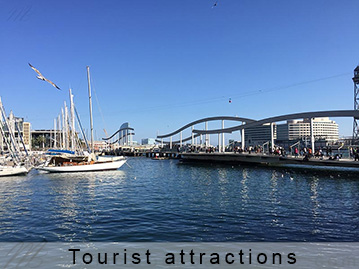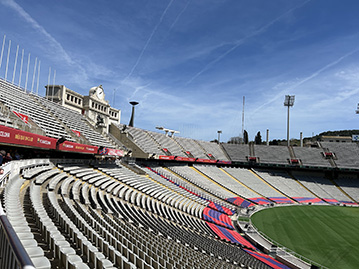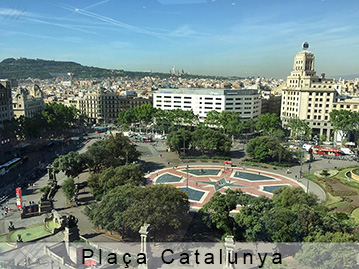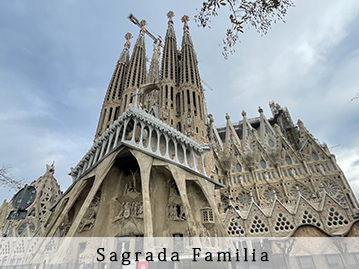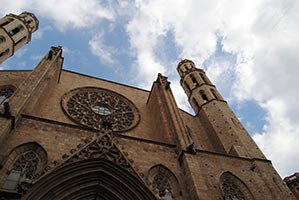how to get around from Casa Batllo
After visiting Casa Batllo, one of Barcelona's most visited monuments, you can easily reach many of Barcelona's other monuments thanks to the metro lines L2 and L4.
- If you want to visit the castle of Montjuic, you will have to go to the Paral-lel metro station using the line 2, located just at the foot of the monument ; Once at the Paral-lel stop, take the funicular railway and up to the foot of the cable car which climbs up to Montjuic Castle, where you can enjoy impressive panoramic views of the city.
- If you wish to travel to the Sagrada Familia from Casa Batllo, simply take the metro line L2 from Passeig de Gracia station to the Sagrada Familia stop.
- To get from Casa Batllo to the Gothic Quarter Cathedral, take the line L4 from Passeig de Gracia to Jaume 1 station.
- If you want to visit the old bullring, which now houses a magnificent shopping center in Plaça Espanya, take the line 3 from Casa Batllo to Espanya station.
- In case you are planning to visit the Palau Guell, take the line L3 and get off at Drassanes metro station, which is just a few steps away from the monument.
- To reach the Parc Güell and the monuments inside it, follow the green line (L3) to the Lesseps metro station, and follow the instructions.

Barcelona monuments
Which are Barcelona's most visited monuments
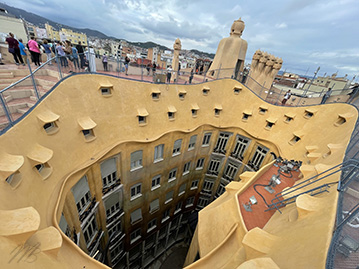
Barcelona's monuments, squares and places not to be missed, the Catalan capital abounds with an exceptional cultural heritage among which internationally renowned architects such as Antoni Gaudi, Joan Miro or Jean Nouvel have left their mark on Barcelona's most important monuments. Find out where and how to discover Barcelona's emblematic sites and monuments.
Barcelona is famous for its modernist architecture, a unique architectural style developed during the end of the 19th and the beginning of the 20th century. Barcelona's modernist monuments are often characterised by their organic forms, their bright colours and their complex designs. Among Barcelona's most famous examples of Modernista architecture are Antoni Gaudí's Sagrada Familia, Lluís Domènech i Montaner's Palau de la Música Catalana and Gaudí's Casa Milà.
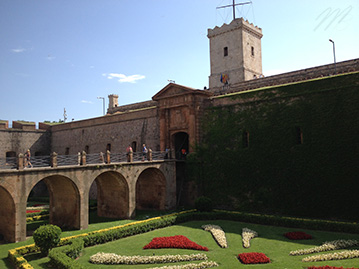
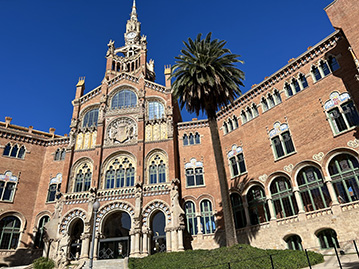
Barcelona best monuments :
Among Gaudi's must-sees
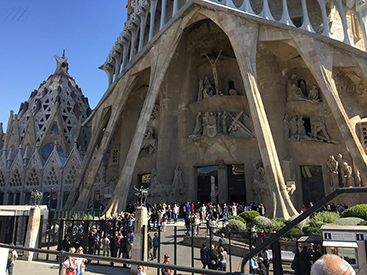
1 - The Sagrada Familia
The Sagrada Familia, Barcelona's minor Catholic basilica and the city's emblematic monument, is one of Antoni Gaudi's craziest architectural undertakings.
Located in the Eixample district, and still under construction today, the Barcelona's most visited monument continues its evolution.
Sagrada Familia online tickets
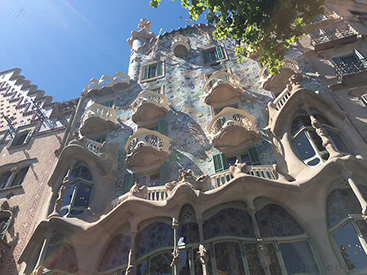
2 - The Casa Batllo
Situated in the heart of Passeig de Gracia Avenue, the Casa Batllo, whose large number of elements recall the human skeleton, is easily remarkable.
The Casa Batllo is one of the many must-see monuments in Barcelona designed by the famous architect Antoni Gaudi.
Casa Batllo online tickets
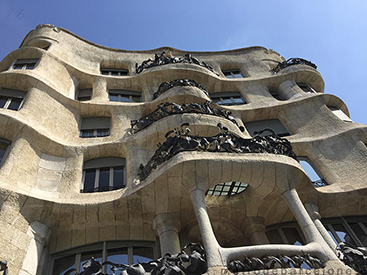
3 - La Pedrera
Located in the Passeig de Gracia Avenue, the Casa Milà, also known as La Pedrera, which means stone quarry, is a huge house with the peculiarity of having no right angles. This monument, which is also one of Antoni Gaui's unmissable masterpieces, is a UNESCO World Heritage Site.
Little preview of your next visitCasa Mila online tickets
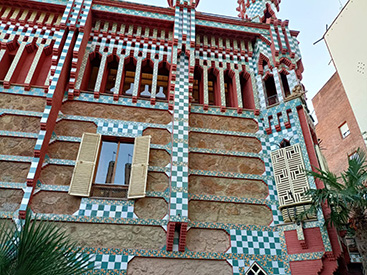
4 - The Casa Vicens
Also classified as a UNESCO World Heritage Site, located in the heart of one of Barcelona's most popular districts (Gracia), the Casa Vicens is one of the earliest masterpieces of the famous Catalan architect Antoni Gaudi.
Little preview of your next visitCasa Vicens online tickets
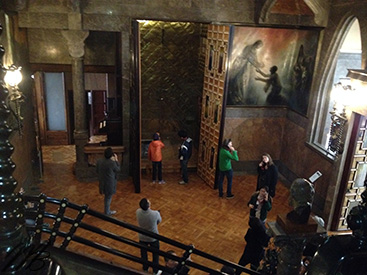
5 - The Palau Guell
From the basement to the terrace, the five floors of Palazzo Guell, home of the wealthy industrialist Eusebi Guell who lived a few steps away from the Ramblas, is one of the works of the famous Antoni Gaudi, who took advantage of the 500 m2 available to build a monument in which no detail leaves one indifferent.
Little preview of your next visitPalau Guell online tickets
Barcelona is a city with a long history and a rich culture. its monuments are testimony to this heritage, dating back to Roman, Gothic and medieval times. Among the most important examples of Barcelona's history and culture are the Gothic Quarter, Montjuïc Castle and Barcelona Cathedral.
Barcelona is also a dynamic city which hosts a thriving artistic and architectural scene. Its contemporary monuments are often audacious and innovative, reflecting current tendencies in art and architecture. Among Barcelona's most famous examples of contemporary art and architecture are Jean Nouvel's Agbar Tower and Gaudí's Parc Güell.
Emblematic monuments
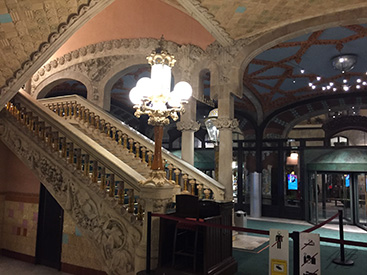
Palau de la Musica Catalana
Historic Catalan modernist monument, declared UNESCO World Heritage Site, the Palau de Musica Catalana is a remarkable concert hall whose design, which incorporates both Catalan tradition and symbolic elements linked to music, is as impressive inside as it is outside.
A preview of your next visit
Palau de la musica Catalana Tickets
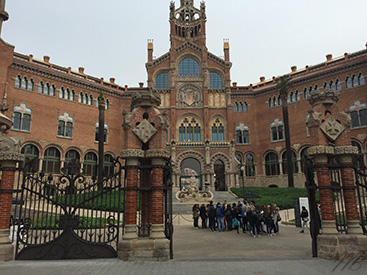
Recinte Modernista Sant Pau
Largest modernist complex in the world, work by Lluís Domènech i Montaner declared a UNESCO World Heritage Site, the Sant Pau hospital is a group of pavilions linked by underground galleries. The Hospital de la Santa Creu i Sant Pau is one of Barcelona's most emblematic Art Nouveau monuments.
A preview of your next visit
Recinte Modernista de Sant Pau Tickets
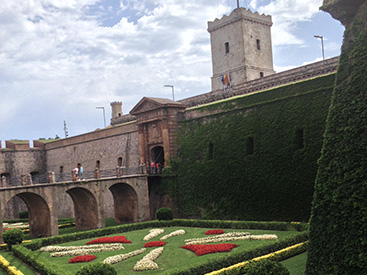
Montjuic Castle
From military fortress to symbol of repression, changing from a prison to a military museum, before becoming one of the Catalan capital's most emblematic sites, the castle that overlooks the city from the top of Montjuic hill is a memorial and cultural site often used at the occasion of cultural events and temporary exhibitions.
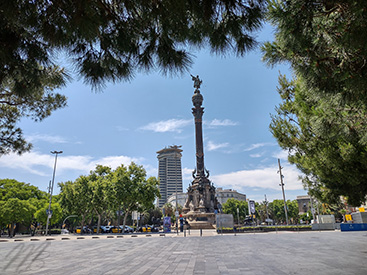
Columbus monument
Located between the end of the Ramblas and the old port of Barcelona, the monument erected in memory of the famous navigator Christopher Columbus is a watchtower from which, once at the top of the column via a tiny lift, the panoramic views over the whole city of Barcelona are impressive.
Little preview of your next visitColumbus llookout online tickets
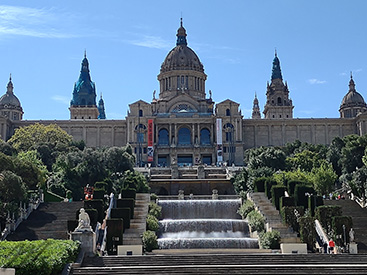
The Palau Nacional
Nestled on the first heights of Montjuic Hill, the Barcelona National Palace was built on the occasion of the 1929 Universal Exhibition. Converted into the National Art Museum of Catalonia in 1934 (MNAC), this monument protects one of the most complete collections of Romanesque art in the world.
Little preview of your next visitMNAC online tickets
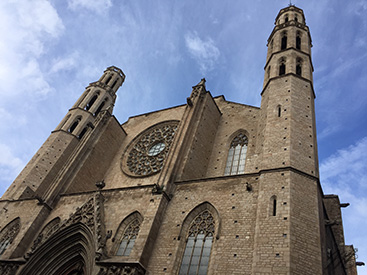
Santa Maria del Mar
In Catalan Gothic style, the church of Santa Maria del mar (Saint Mary of the Sea) is the result of a work to which the inhabitants of the Ribera district of Barcelona contributed with great will. Dedicated to the Virgin of the Sea, this historical monument of Barcelona is an unmissable site,
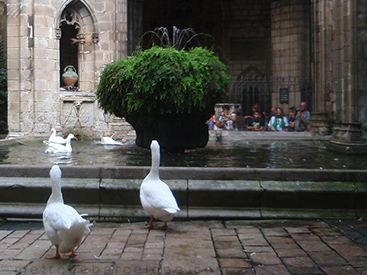
Santa Creu Cathedral
The Metropolitan Basilica Cathedral of the Santa Cruz and Santa Eulalia of Barcelona is permanently inhabited by 13 geese that protect the cloister.
Mainly built between 1298 and 1450, the magnificent Gothic-style cathedral has been classified as a national historic-artistic monument since 1929.
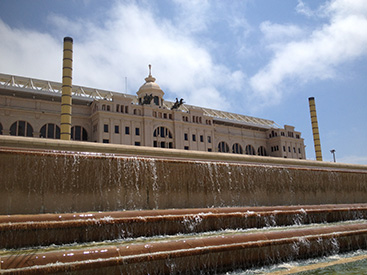
Montjuic Olympic Stadium
Olympic Stadium, Palacio Sant Jordi, or swimming pools, the Montjuic complex's facilities represent 1/4 of Barcelona's facilities for the 1992 Olympic Games. Situated on the hill of Barcelona, the Olympic Games' vesticles are part of the walk up to the summit of Montjuic.
Little preview of your next visit
Olympic & Sports Museum tickets
Upgrade your stay

Barcelona's monuments quick tour
If your time to explore Barcelona's most beautiful monuments is very limited, which can be the case during a cruise stop in the Catalan capital, follow the green line of the metro and move from monuments to squares and parks that are not to be missed.
Taking the Drassanes metro station, which is the closest to the port, as a landmark, the green line (3) takes you to the foot of the city's exceptional architectural treasures.
Taking this line in the direction of Trinitat Nova, you have access to the Ramblas, Plaça Catalunya, Casa Batllo, as well as La Pedrera, the district of Gracia, the inevitable Guell Park, not forgetting the magnificent Labyrinth Park.
Taking the same metro line in the direction of Zona Universitaria, again from Drassanes, you head towards the Montjuic hill and its Olympic vesticles, the old bullring in Barcelona, the Joan Miro park or the Palau Reial gardens.
Barcelona monuments + metro
- Columbus column - Drassanes
- Palau Guell - Drassanes
- Plaza Real - Liceu
- Plaza Cataluña - Catalunya
- Casa Batllo - Passeig de Gracia
- Casa Mila - Diagonal
- Park Guell - Lesseps
- Barcelona bulring - Espanya
- Palau Reial - Palau Reial
- FC Barcelona stadium - Maria Cristina
Barcelona exceptional sights
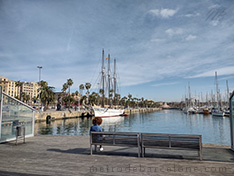
Barcelona port Vell
Bordered by a very pleasant promenade that stretches from Christopher Columbus monument to Barceloneta, and reaches to the beaches of Barcelona, the Port Vell is the oldest port in the city.
Barcelona port Vell ticketsVirtual trip to Barcelona old port
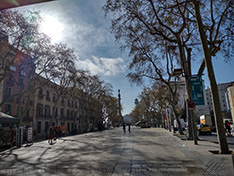
Barcelona Rambla
Meeting point between Plaça Catalunya and Port Vell, the Barcelona's Rambla represents the 2 kilometres of the city's busiest pedestrian avenues, where artists, painters and musicians give the greatest tourists satisfaction.
Tourist attractions onlineLittle preview of your next visit
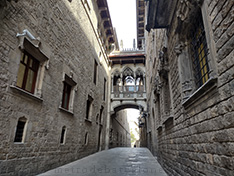
Gothic Quarter tour
Maze of alleys between Raval and Born where museums, churches, Roman vestigations and architecture retrace the history of Barcelona's oldest district that stretches along the Ramblas from the old port to the Plaza Cataluña.
Gothic Quarter guided tourBarcelona Gothic Quarter walk
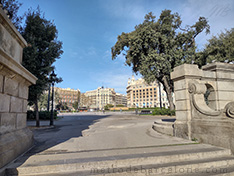
Plaza Cataluña
As a very important intersection of the city, and a rallying point served by a large number of transports, Plaça Catalunya is one of the most recommended meeting points to get to the centre of Barcelona, where the pigeons have established their headquarters.
Little preview of your next visit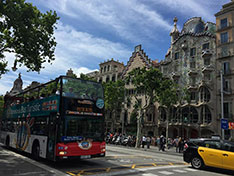
Passeig de Gracia
The Paseo de Gracia (Passeig de Gracia), Barcelona's fashion boulevard where monuments, exceptional architecture, restaurants and boutiques of famous brands such as Hermés, Chanel or Diesel share the 1.5 kilometres that connect Plaça Catalunya to the Gracia district.
Quick visit of the Passeig de Gracia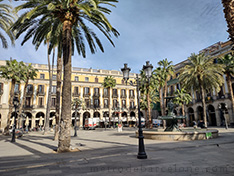
Plaza Real
After almost giving way to a theatre, Barcelona's old religious building (Capuchin convent) was converted into a magnificent square, the Plaça Reial (Royal Square), which is the only arcaded square in Barcelona. It is located a stone's throw from the famous Ramblas of Barcelona.Virtual tour on Barcelona's Plaça Reial
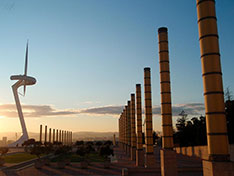
Barcelona Montjuic hill
From its 184-metre height, which houses the remains of the 1992 Olympic Games as well as beautiful parks and museums, Montjuic Hill is one of Barcelona's most visited tourist sites, offering exceptional panoramic views.
Buy now and save timeLittle preview of your next visit
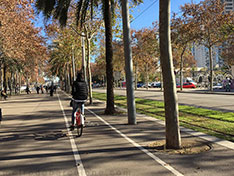
Diagonal Avenue
Leisure, business, entertainment, curiosities and rest, Barcelona's Avenida Diagonal, one of the most important thoroughfares in Barcelona, which stretches from one end of the city to the other, from the Forum to the university zone, offers access to many of Barcelona's unmissable sites.
Little preview of your next visitFrom monument to monument
Sagrada Familia, which monument to visit near Sagrada Familia
After having discovered the most visited monument in Barcelona, the Sagrada Familia, you are not far from the Passeig de Gracia where you will find two monuments that cannot be ignored.
Take the metro to Passeig de Gracia station, following line 2 towards Paral-lel to reach the foot of the Casa Batllo. To continue, you can go up the Passeig de Gracia avenue and meet another of Barcelona's not-to-be-missed monuments, the Casa Mila (la Pedrera).
How to get to Barça Stadium from Sagrada Familia
To travel between the FC Barcelona stadium (Camp Nou) and the Sagrada Familia, there are only a few subway stations ; just follow the metro line 5 (blue) between Sagrada Familia and Collblanc stations.
From Casa Batllo to Montjuic Castle
After visiting the Casa Batllo, one of the most visited monuments in Barcelona, you should head for the Paral-lel metro station on Barcelona metro line 2, which is easily accessible at the foot of the monument ; Once at Paral-lel stop, take the funicular up to the foot of the cable car that climbs to the Montjuic castle from where the panoramic views of the city are impressive.
Monuments bundles
BCN Essentials Pass
The pack that includes the reservation of your tickets for the Sagrada Familia and Parc Guell on the one hand, an unlimited access to public transport on the other hand, as well as a Barcelona audioguide for smartphones.
More about this pack Book this package onlineThree Gaudi houses
A monumental package that opens the doors to three of Antoni Gaudi's greatest monuments. Buy your tickets to visit the Casa Batllo, the Casa Milà and the Casa Vicens. This pack also includes an audio guide to Barcelona.
Find out more about this pack Book this package onlineBarcelona Pass
A package that not only offers you the chance to visit Barcelona from the comfort of a hop-on hop-off bus, but also your entry tickets for access to the Sagrada Familia as well as the magnificent Parc Guell. This pack also includes an audio guide to Barcelona and the Parc Guell.
More details about this pack Book this package hereBest of Barcelona
Le package "Best of Barcelona", an offer that includes 3 of Barcelona's must-see sights. Discover the Sagrada Familia, passing through the Casa Batllo before stopping off at the Parc Guell. This pack also includes an audio guide to the city.
Learn more about this package Book this offer onlineTransports + Pack Gaudi
As well as unlimited access to Barcelona's public transport network, this pass includes not only access to the Sagrada Familia, the Park Guell, the Picasso Museum, the Olympic Museum, the Fundació Joan Miró and many other museums, but also a wide range of discounts at emblematic sites such as the Casa Batllo, the Casa Milà and the Casa Vicens.
Read more about this pack Buy this package nowArt Nouveau pass
With the pass "Barcelona Domenech i Montaner", discover 2 exceptional monuments that illustrate the history of the Art Nouveau ("Modernism") in Barcelona. As well as 2 fast-track tickets to access the Palau de la Música and the Sant Pau Hospital site, enjoy a Catalan culinary break at the modernist café Casa Fuster.
Read more about this pack Buy this package now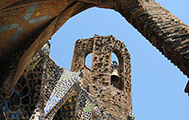 From the Sagrada Familia to the Palau de la Musica Catalana, passing by the Casa Batllo or Casa Mila, which of the city's metro lines and stations lead to the foot of Barcelona's most important monuments to visit during your stay.
From the Sagrada Familia to the Palau de la Musica Catalana, passing by the Casa Batllo or Casa Mila, which of the city's metro lines and stations lead to the foot of Barcelona's most important monuments to visit during your stay.
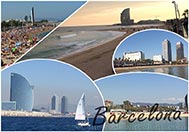 metrodebarcelone.com, your Barcelona travel guide
metrodebarcelone.com, your Barcelona travel guide


